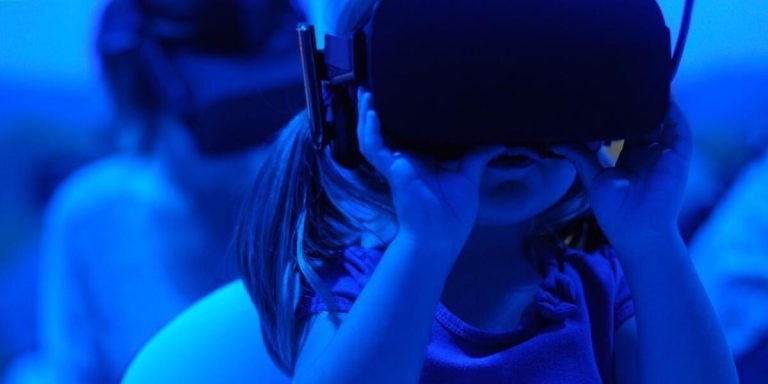Technological Evolution: Influencing Modern Childhood Education
The unprecedented pace of technological evolution is dramatically reshaping various sectors, including education. In the context of childhood education, it’s crucial to understand how this transformation influences teaching methodologies and learning environments. Incorporating technology into classrooms can be pivotal in offering an enriched educational experience for students while effectively engaging their curiosity.
This digital twist on traditional methods has resulted in a seamless blend between physical classroom settings and virtual learning platforms. It not only generates flexibility but also opens up new realms of creativity for young learners to explore. Geared towards individual needs and capabilities, modern childhood education thrives on integration with technology which significantly enhances its effectiveness.
Did you know?
Did you know that children who learn with educational technology from a young age not only show increased tech-skills but also improved linguistic and cognitive abilities? This is according to a study by the Journal of Educational Psychology.
The Role of Technological Evolution in Modernizing Classroom Environments
The role of technological evolution in reshaping and modernizing classroom environments is undeniable. In our rapidly evolving digital era, technology has become an integral part of education, transforming the way students learn and educators teach. With modern tools like smartboards replacing traditional blackboards and iPads becoming regular companions for students instead of bulky textbooks, classrooms now have transformed into high-tech learning places which are interactive, engaging and efficient.
In-depth integration allows teachers to tap into rich media content online that can help complement their lesson plans. Gone are the days where information was one-sided – from teacher to student. Now with forums for collaborative work such as Google Classroom or Microsoft Teams children also get a chance not only interact with each other but share ideas problem-solve together; instilling teamwork at a very young age through virtual mediums.
Embracing Interactive Digital Tools for Enhanced Learning Experiences
Technological evolution has revolutionized the way we approach childhood education. The classroom environment now resonates with interactive digital tools that tremendously enhance learning experiences and enable students to absorb knowledge in a more engaging manner.
First, let’s discuss mobile apps designed for educational purposes. These technological miracles provide kids with a platform where they can learn at their own pace while having fun – an amalgamation of entertainment and education unheard of before this era. From simple math puzzles to complex coding basics, these applications stimulate cognitive functions whilst keeping their interest piqued.
Next are Virtual Reality (VR) and Augmented Reality (AR) technologies which create immersive learning environments like never before seen in traditional classrooms. A world where geography lessons involve digital tours around the globe or biology classes evolve from two-dimensional drawings to three-dimensional explorations within the human body – all from your desk!
Additionally, online collaborative platforms have given birth to a new level of interaction among peers as well as between teachers and students. Not only do these virtual spaces replicate real-life brainstorming sessions but also foster teamwork regardless of geographical boundaries.
Moreover, technological evolution introduces us to adaptive learning software programs tailored towards individual student’s capabilities – something conventional teaching methods might find harder achieving on larger scales due its uniform application nature.
Infrastructure Upgrades: Supporting Tech-Driven Educational Ecosystems
The steady march of technological evolution has brought transformative changes to numerous sectors, including education. Perhaps nowhere is this more apparent than in the modernization of classroom environments – a process driven by infrastructure upgrades and an increased focus on creating tech-driven educational ecosystems.
Technological innovation, particularly in the form of digital tools and platforms, has revamped classrooms into interactive hubs for learning. The traditional image of desks lined up before a blackboard is giving way to dynamic spaces populated with smart devices where teachers and students interact seamlessly across physical and virtual divides.
Infrastructure upgrades are key enablers behind such advancement. One critical area here involves equipping schools with reliable high-speed broadband connections that can support multimedia-rich online learning resources simultaneously accessed by multiple users.
Bridging the Gap: Adaptive Learning Platforms and Personalized Education
The revolutionary shift brought about by technological evolution in the education sector is both enlightening and transformative. As we navigate through this new digital era, adaptive learning platforms are emerging as pivotal tools to bridge conventional teaching methods with a more modern, personalized approach in 2023.
Adaptive Learning Platforms use innovative technologies to customize curriculum based on individual student’s needs. They intelligently analyze learners’ strengths and weaknesses while continually adjusting their strategy according to pupil progress. The data these platforms generate provide invaluable insights that help educators devise effective teaching strategies tailored for each learner – thus fostering an environment of personalized education.
Modern schools integrate advanced systems into their academic framework. Previously adopted one-size-fits-all pedagogies have given way to advancements that allow teachers to understand students at granular levels. These advancements:
- Promote seamless inclusivity.
- Significantly reduce gaps in comprehension abilities among pupils within the same classrooms or age groups.
This ensures equal opportunities for success for every child, highlighting the indispensable role of technology. Technology acts as a catalyst propelling businesses forward and fundamentally reshaping approaches to imparting quality childhood education.
Customizable Content Delivery Through AI and Machine Learning
In the ceaselessly evolving terrain of childhood education, technological evolution has served to be a catalyst to significant advancements. One such progress is the concept of customizable content delivery through Artificial Intelligence (AI) and Machine Learning.
The surge in edtech tools’ adoption reflects society’s realization that technology integration in education can bring exceptional results like never before. AI and machine learning are no longer buzzwords but integral elements within contemporary teaching methodologies.
Customizable content delivery echoes precisely what it suggests- an educational approach tailored for each child. It employs AI algorithms and machine learning models to understand learners’ unique needs, enhancing their academic journey with personalized touchpoints.
For starters, artificial intelligence leverages its pattern recognition abilities for student engagement analysis. This data-driven insight allows educators or software systems themselves to identify any potential obstacles impeding a learner’s growth promptly.
Machine learning further fine-tunes this process by programming itself based on past experiences i.e., students’ response patterns over time – just as we humans learn from our mistakes!
Moreover, ‘adaptive tests’, another gem powered by AI & ML techs helps gauge students’ skill level very accurately determining their strengths and weaknesses—all thanks again due to advanced analytics techniques underpinning them!
Tracking Progress with Data Analytics to Tailor Student Instruction
Advancements in education are coming at a rapid pace, and it’s not just chalkboards making way for interactive white-boards. The technological evolution has permeated deeply into how educators approach teaching strategies and progress monitoring. More significantly, data analytics is revolutionizing the concept of personalized instruction.
Data analytics involves taking raw data from different sources and using it to generate useful insights. In an educational context, these can unravel trends regarding student performance that may be crucial in designing tailored instructional methods.
Firstly, one major benefit of integrating technology like adaptive learning platforms is instant feedback on students’ understanding levels. Teachers no longer need to spend hours grading papers – they have real-time result analyses readily available instead! By identifying where learners excel or struggle instantly enables teachers to adjust their lessons accordingly ensuring better comprehension across all topics covered.
Secondly, with granular visibility into every learner’s skills gaps ensures resources allocation efficiently by focusing only on those areas requiring additional support rather than blanket-training entire classrooms which could leave certain learners disengaged while others might still lag behind despite standard training modules employed commonly without tracking individual needs specifically through data analysis.
Preparing for the Future: Cultivating Digital Literacy and Critical Thinking Skills
In the era of rapid technological evolution, education is not left untouched. Schools and educators globally are recognizing the crucial role technology plays in enhancing learning experiences for students. The focus has shifted from traditional pedagogy to fostering environments stimulating digital literacy and critical thinking skills, gearing children up for a tech-driven future.
Embracing this transformation requires integrating educational technologies into classroom teaching methods. Technology integration isn’t merely about having high-tech devices at disposal; it’s more so about utilizing these tools effectively to boost student engagement and facilitate knowledge acquisition seamlessly.
Teachers today, therefore, aren’t just imparting lessons outlined in textbooks but also cultivating vital 21st-century competencies like digital literacy – understanding how information flows across networks securely or using software applications proficiently– among their pupils. Alongside nurturing critical-thinking capacities that equip learners with abilities of wise decision making when dealing with countless data available online.
Moreover, such an approach prepares youth for potential careers dominated by artificial intelligence (AI), virtual reality (VR) systems, robotics amongst others fields reflective of current technological innovations we’re witnessing at present year -2023-. Resultantly leading towards generating generations powered not only with profound academic wisdom but skills aligning them adeptly within our steadily modernizing global society.
Implementing Coding and Robotics Programs in Curriculum Development
Understanding the importance of technological evolution within our society, implementing coding and robotics programs in curriculum development has been a revolutionary undertaking. As we navigate through 2023, technology integration in education continues to take shape by educating young minds as early as possible with these skills.
Coding teaches children about problem-solving and logical reasoning – key aspects that are essential for their future success. A child not only learns how to make decisions but also understands that every action will have a reaction – similar to sequences seen in programming language codes! By introducing them to this world at an early stage, they learn from trial-and-error experiences, which aids significantly in fostering resilience.
On the other hand, Robotics allows budding techies actually see what’s behind those screens; it brings digital processes into physical reality giving them substantial understanding of abstract concepts. Children enjoy interacting with things they can touch and manipulate making robots perfect tools for interactive learning while creating fun-filled educational environment simultaneously!
Implementing both fields is like teaching new languages—profoundly different from ours—but critical ones nonetheless given where humanity’s path lies ahead considering rapid advances being made across tech space today. These programs add tangible value preparing youngsters tackle challenges head-on especially since most jobs tomorrow won’t look anything like traditional roles now due largely part continuous shift towards digitization taking place globally.
Leveraging Multimedia Resources to Foster Engagement and Creativity
Today’s swift technological evolution offers the unique potential to stir creativity and engagement among learners. By leveraging multimedia resources, educators can cultivate a deeply immersive learning environment that fuels students’ interest while fostering critical thinking.
Multimedia tools are no longer an option but have become an integral part of modern education systems in 2023. These various digital platforms help transmit complex information simplistically, encouraging active participation from students.
1. Using Interactive Videos: Learners’ comprehension improves when they watch informative videos about intricate concepts instead of merely reading texts or listening to lectures.
2. E-books & Digital Texts: With hyperlinks and embedded dictionaries, these provide children with easy access to comprehensive knowledge independently without interrupting their study flow for clarifications.
3. Virtual Reality (VR) Tours: VR brings experiential learning at your fingertips – whether it’s exploring deep-sea ecosystems or observing space galaxies – all within safe confines!
4. Online Art Platforms: They stimulate artistic proclivities by providing countless art forms such as painting, sketching, sculpturing etc., tapping into every child’s creative potential.
5.Explorative Games & Simulations : Children learn best through play! Educational games give them opportunity practice problem-solving skills in dynamic virtual settings.
6.Podcast And Audio Books : For auditory learners , having lessons delivered via clear narrations is instrumental . They also foster independence since kids can listen anytime anywhere .
Conclusion
In the dynamic world we inhabit, it’s undeniable that technological evolution is reshaping not only our day-to-day lives but also how we educate our young ones. With proper guidance and balance, this revolution can lead to extraordinary strides in comprehension and innovation in childhood education.
Yet remember, technology is just a tool – its effectiveness ultimately lies with us: educators and parents. For more insights on children’s education or support for parents and educators navigating these changes, feel free to explore other articles on our website! We are dedicated to empowering you with knowledge as we all traverse the exciting terrain of modern childhood education.







